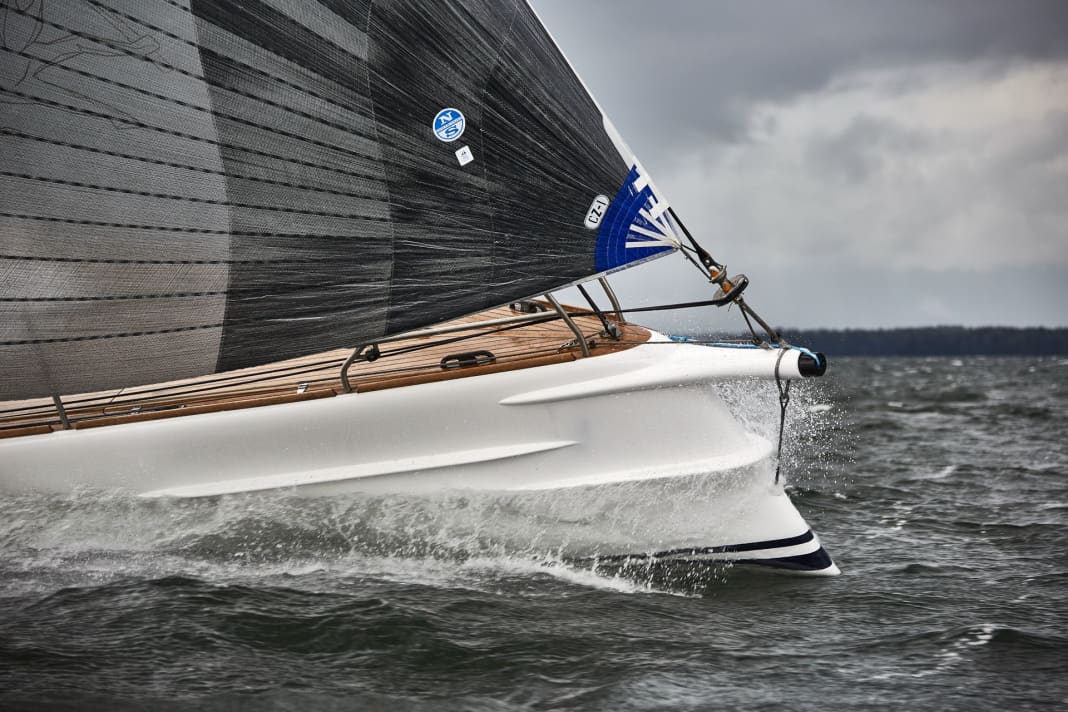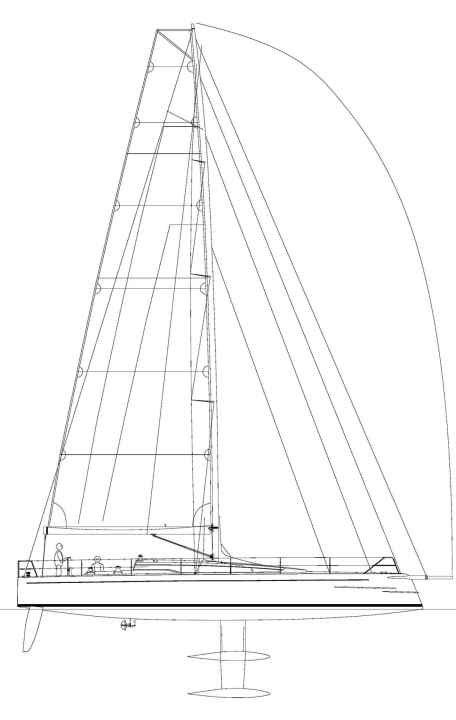





Actually, nothing fits: the plane is late, hardly any wind, plus a weather forecast predicting an air temperature of eight degrees and heavy continuous rain - but then this boat immediately makes any adverse circumstances fade into the background. Even when moored, the Shogun is a beast: aggressive yet elegantly flowing lines, even the teak deck follows the contours of the hull. And then there's the negative stem with its striking spray rails, which continues the angle of the forestay. And then there's the extendable gennaker pole - it's hard to believe that this projectile was built by the Swedish Rosättra Båtvarv. Their Linjetts are right next to it. Although they are not considered to be slow, they stand for dignified cruisers with a timeless design and top-quality workmanship instead of radical looks and consistent lightweight construction.
"Shogun 50" - A lightweight construction made of carbon fibre
The Shogun 50 cruising yacht is the blatant alternative. The 50-footer made of full carbon weighs just 7.8 tonnes despite its lifting keel. That is almost 500 kilograms less than a Club Swan 50 weighs. It is no coincidence that the Shogun resembles the Finnish noble racer. Owner and initiator Mats Bergryd originally ordered the first Swan in Finland. However, the Swan's enormous draught severely restricted sailing in the Stockholm archipelago. In addition, the concept, which was designed for large crews, proved to be impractical for him. "Mats didn't always want to have to call a football team to go sailing," says Shogun designer Håkan Södergren, who is friends with the owner and was able to land the order for the boat over lunch together.
Other interesting cruising yachts:
The requirements were clear: just as fast and elegant as the Swan, but with less draught. The boat also had to be manageable by a family crew, be suitable for regattas and have a cosy interior.
The cruising yacht should be suitable for everyday use
An ambitious task for father and son team Håkan and Oscar Södergren. The list of specialists they brought on board reads like a who's who of Swedish high-tech boatbuilding. Sandwich material producer Diab was responsible for calculating the laminate and milling the foam core, while the negative moulds were milled at Macromould. The lifting keel, rig and rudder were made by
Carbon experts Marström Composite and are baked in an autoclave at six bar overpressure. Vaxholm Composite provides the expertise for epoxy vacuum infusion. Although the hulls of the Linjetts have also been built with vinyl ester resin using the infusion process for five years, a super-light carbon fibre-epoxy sandwich requires more experience. Together with the boat builders at the Rosättra shipyard, this resulted in a very competent and efficient alliance. It took just 18 months from the first sketch to the finished boat.
Back on board the cruising yacht: the grey clouds loom menacingly over the Åland Sea. The weather radar still promises an hour or two of dry weather before the steady rain sets in. A quick orientation in the huge cockpit, then off we go. Designer Södergren skilfully manoeuvres the Shogun out of the pits. He is the only one of the crew to have experienced the boat under sail.
The Shogun has already won its first race with the owner's crew at the ORCi World Championship off Oxelösund. But even shipyard manager Markus Gustafsson and project manager Daniel Gustafsson have not yet travelled with her.
The cruising yacht can also be sailed with a small crew
We motor out into the narrow Vätö Sound, then we can finally sail. At the push of a button, the keel slides down, and instead of a harbour-friendly two metres, the massive carbon fin now reaches down a full 3.5 metres. The next button causes the huge matt black mainsail to climb up the mast. The carbon fibre tube is positioned behind the keel, creating an unusually large foresail triangle. "This allows us to use a self-tacking jib with a surface area of 60 square metres and sail the boat comfortably even with a small crew," explains the designer.
Whereby the term comfortable is relative. The cockpit layout is that of a racer with dedicated workstations for the trimmers. If you can't man all positions and still want to do more than just sail for coffee, you have to move around a lot and often leave the helm to the autopilot. E-winches should also be on board. Owner Bergryd has only electrified the halyard winches; the mainsheet, genoa sheet and backstays are trimmed using four-speed winches from Karver. This saves weight, but also requires significantly more physical effort.
The same applies to the jib. It is not furled, but set with webbing stays. From 20 knots, you can switch to a cutter jib, which is set on the fly together with the furling system. The halyards, which are barely eight millimetres thick, are striking. All sails are fitted with locks so that the lines only have to bear a small amount of weight. Once preheated, the lock engages on the mast. The halyard tension is then trimmed from the helm using hydraulic Cunnigham systems from Reckmann. Load sensors integrated into the instrument system provide the necessary feedback.
Speed characterises the cruising yacht
Even with the main and jib, it is clear how agile the Shogun sails. Although the wind barely exceeds eight knots, the log shows around 7 knots on the centreline. The twin rudder system reacts very directly, which is also due to the comparatively large blades.
Due to the mast position being moved far aft, the sail pressure point also moves towards the stern and the rudder system has to provide a larger proportion of the lateral surface. "We have chosen a good-natured profile. As a result, the blades generate more effect and the flow does not break off even in extreme conditions," says Södergren, explaining the setup.
Although 7 knots is not bad, the Shogun has much more potential. A gennaker would actually be appropriate. However, in view of the narrow archipelago fairway, the weather development with incipient gusts and the crew of only five people, the designer urges caution. After all, the cloth measures 230 square metres and almost pulled the foreship crew overboard during the last recovery. So much for the family crew.
The sailing characteristics of the "Shogun 50"
Instead, we use the 145 square metre Code Zero. This doubles the sail area, but can be rolled away relatively easily if necessary. As soon as the sail is trimmed, the Shogun shows what it's made of - and the additional heel is particularly noticeable. The slim hull and narrow waterline offer very little initial stability. Only when the situation increases does the 3.5 tonne keel bomb have an effect. The log puts the unspectacular sensation into perspective, reporting double-digit values from then on.
Then the approaching cloud front sends up the first gusts. The Shogun briefly picks up a couple of degrees, the wind seems to be peeling strongly, and fine mist rises from the bow. A glance at the log: 13, 14, 15 knots - and then the push is through. We immediately look to windward - is there more to come? Right, the next dark spot is approaching on the water. This time everyone is forewarned and trims immediately. And with success: the log soars upwards - 14, 15, 16, 16.5 knots, that's it.
After another five minutes, the exercise is complete and the crew is in an endorphin rush. There is no need to look at the log. As soon as the fine spray plume blows over the stem to windward, we are travelling at more than 16 knots. It's hard to imagine the fireworks the Shogun must set off under gennaker. Then the rain comes and with it the calm. The return trip to the shipyard is wet, cold and comparatively tough. Much more than
7 knots are no longer possible, but the height is spectacular: it feels like the Windex is pointing directly forwards. The electronic measuring instrument reports a true wind angle of 38 degrees, the apparent value is around 19 degrees.
The cruising yacht thrives in light winds
Especially in light winds, the Shogun shows off its slim lines and light weight. The cold slowly creeps under the wet oilskins. It's a good thing that the diesel heater is already running and there's no naked racer waiting below deck. On the contrary, the interior is extremely cosy. The building material only appears in the form of the keel box and as a design element. Bulkheads, fronts and floorboards are veneered with light-coloured oak, and even the door frames give the impression of being made of solid wood.
Foam cores with wafer-thin carbon fibre layers are concealed behind all components. The ceiling panels, which not only ensure pleasant acoustics, but also feature extremely small and even gaps, play a large part in the cosy feel. Behind this is more than just the expert hand of the boat builders: the cruising yacht was designed down to the last detail on the computer. The data obtained was then used to elaborately mill negative moulds for all components and panelling.
A lot of work and a perfect finish
Oscar Södergren invested around 1500 working hours in engineering alone, i.e. the feasibility of the design solutions. This was followed by mould making and vacuum infusion of the carbon components. The reward for the effort: even complicated elements have a perfect finish without the need for an ounce of filler.
"The large visible carbon fibre parts for the bathroom, navigation and especially in the galley were a challenge," says project manager Daniel Gustafson. The clear surface acts almost like a magnifying glass, revealing even the slightest irregularity in the fibres.
Bergryd had its own ideas for the layout of the interior. To make the boat suitable for long-distance regattas, such as the ÅF Offshore Race or the Caribbean 600, there is no classic saloon. Instead, there is a large work area on the companionway where sails can be stowed and prepared for changing. The navigation centre and an oil locker are also located there. Towards the bow is the solid keel box, which also separates the bathroom and galley. There are no sea berths, as the free watch sleeps on the high edge in regatta mode.
The actual living area is divided between the two symmetrical aft compartments, which are rather small considering the size of the boat, and the foredeck. However, there is no real owner's cabin there, but a large U-shaped sofa with space for six people. The superstructure, which is pulled far forward, and the deck hatches make it pleasantly bright despite the cloudy sky.
One-off with potential for series production
Nevertheless, the layout with the saloon shifted to the bow is special. For potential owners who want more privacy, Södergren has therefore designed a variant with a conventional layout and separate forward cabin.
The Shogun 50 is currently a one-off. However, the construction in negative moulds has the potential for a small series. This would also put the construction costs into perspective. According to Daniel Gustafsson, around 11,000 hours have gone into the cruising yacht, not including mould construction. He estimates that the next construction number could be completed in around 7500 hours. An owner has to invest around 1.5 million euros in the Shogun 50. This puts it at around the same level as a ClubSwan 50, but it offers variable draught and is much more customisable than the Finnish standard class.
This article first appeared in YACHT 2/2020 and has been revised for this online version.
Technical data "Shogun 50"

- Hull length: 15.20 m
- Waterline length: 14.20 m
- Width: 3.88 m
- Draught: 2.00-3.50 m
- Weight: 7.8 tonnes
- Sail area: 138 m²
- Sail carrying capacity: 5.6

